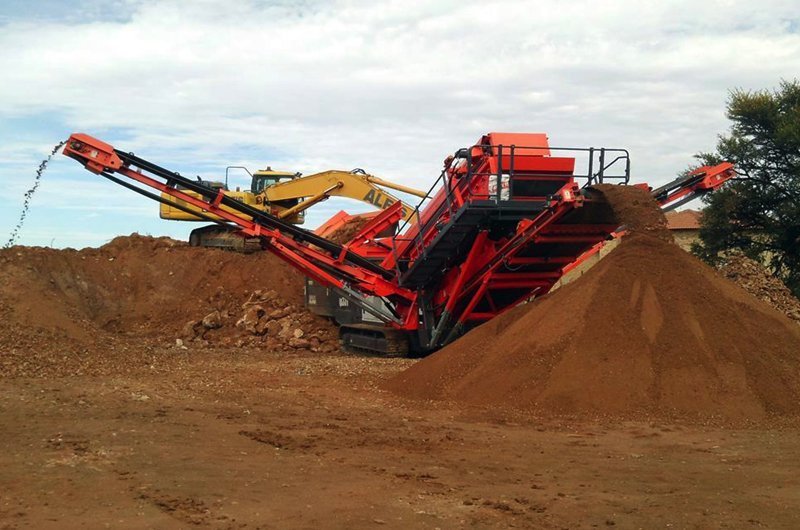RECYCLED CONCRETE AGGREGATES
Learn how you can make profit from recycling concrete into products
Call us: +45 97 17 70 66
What are Recycled Concrete Aggregates (RCA)
Recycled concrete aggregate is aggregate made from used concrete from demolition sites. The quantity of old concrete from a demolition site depends on the type of building. For example, the list below shows the percentage of concrete for various building types.
- Housing 47%
- Leisure 50%
- School 68%
The definition of Recycled concrete aggregate is it contains less than 5% of other hard materials such as brick and contain no inert or organic materials.
The Process to Produce Recycled Concrete Aggregate
Remove as much material from the building before demolition that can cause contamination, asbestos for example.
Remove the concrete elements such as the floors, frame and walls and move to one site for sorting.
Remove any glass, wood, plastic and metal. The use of an electromagnet can remove steel, including rebar.
Crush the concrete with a jaw crusher, impactor or cone crusher. Small pieces of scrap metal often go through the concrete crusher. After processing, it can be removed using an electromagnet.
The concrete may go through a jawbreaker first, then an impactor and finally sorted using a screener. The screener will stockpile the crushed concrete into aggregate size, for example, 25mm 12mm 5mm to dust.

Jaw Crushers
A jaw crusher breaks down the concrete between two verticle jaws.
A weighted flywheel powers the jaws. One jaw is fixed and the other swing jaw moves backwards and forwards. The concrete is crushed using compressive force.
Jaw crushers are versatile and economical.
They are perfect for processing hard and abrasive materials. Jaw crushers and simple machines and have a low maintenance cost compared to other machinery.

Impact Crusher
As the name implies, Impact crushes use impacts to crush material. Instead of applying compression to break the concrete, they use the impact of hammers. A hammer mill or horizontal shaft impactor, break the concrete by hitting it with heavy hammers that are fixed to a spinning shaft. An impact crusher is good to crush softer, nonabrasive materials.
Vertical shaft impactor crushers work by slinging pieces of concrete against the hard surface of the anvil. Velocity is used for crushing the material.
Vertical shaft impactor crushers are very good at handling more abrasive materials than horizontal compactors.
Impact crushers are very good at separating rebar and wire mesh from concrete. They are also easy to maintain with wearing parts being simple to replace.

Cone Crushers
Cone crushers work by squeezing the concrete through an eccentrically gyrating spindle and hopper.
Concrete enters the crusher and is squeezed between the spindle’s mantel and the hopper liner.
The small sections fall through for further treatment, and the larger pieces remain until they break down.
Cone crushers have a sturdy construction, lower operating costs, and are simple to adjust. They also offer high productivity rates as they can process wet material.

Screener
Once the concrete has been crushed, it is a mixture of lots of aggregate sizes. To allow the aggregate to be mixed into concrete they need to be separated. Once the material is separated a concrete technician can design the concrete mix.
Separation is carried out by putting the material through a screener. The screener will sort the material into aggregate sizes.
The material is passed over a vibrating screen box that has several different gauges. The material passes through the various screens to separate the aggregates. A belt conveyor then transports the aggregate to individual stockpiles for use.
Power screen equipment is either track or wheel mounted to make them mobile. This means the Power screen machine can move to the raw material rather than the expensive movement of the material to the screen. Click on the link for more information on concrete recycling production.

Cost to Produce Recycled Concrete Aggregate
Cost to produce recycled concrete aggregate range from £5 to £12 per tonne. The cost depends on the quantity, the quality of demolished concrete, and the size and type of plant being used.
Lowest cost comes from large quantities of demolished concrete using high output plant and machinery.
Benefits of Recycled Concrete Aggregates
Recycling demolition concrete is eco-friendly as it preserves natural stone resources. The process uses less energy than mining and reduces the carbon footprint. When concrete is produced on the site where the material has been processed, the reduction in transport costs is significant.
Using recycled concrete gives the contractor LEED or BREEAM points. When tendering for work, the more LEED points that can be provided for a good recycling plan can be the difference between winning or losing the project.
The crushed concrete aggregate has a faster initial set time than virgin material, is lighter in weight, and simpler to place. When it has the right proportions, it has the same shrinkage properties as other concrete.
Recycled concrete aggregate is more economical than using virgin aggregates. The use of the circular economy is a great benefit to protect our natural resources.
How To Convert 150 ton of Recycled Concrete into 20,000 Building Blocks
Select The Batching Plant For Your Project
Let’s find your solution
Call us: +45 97 17 70 66

